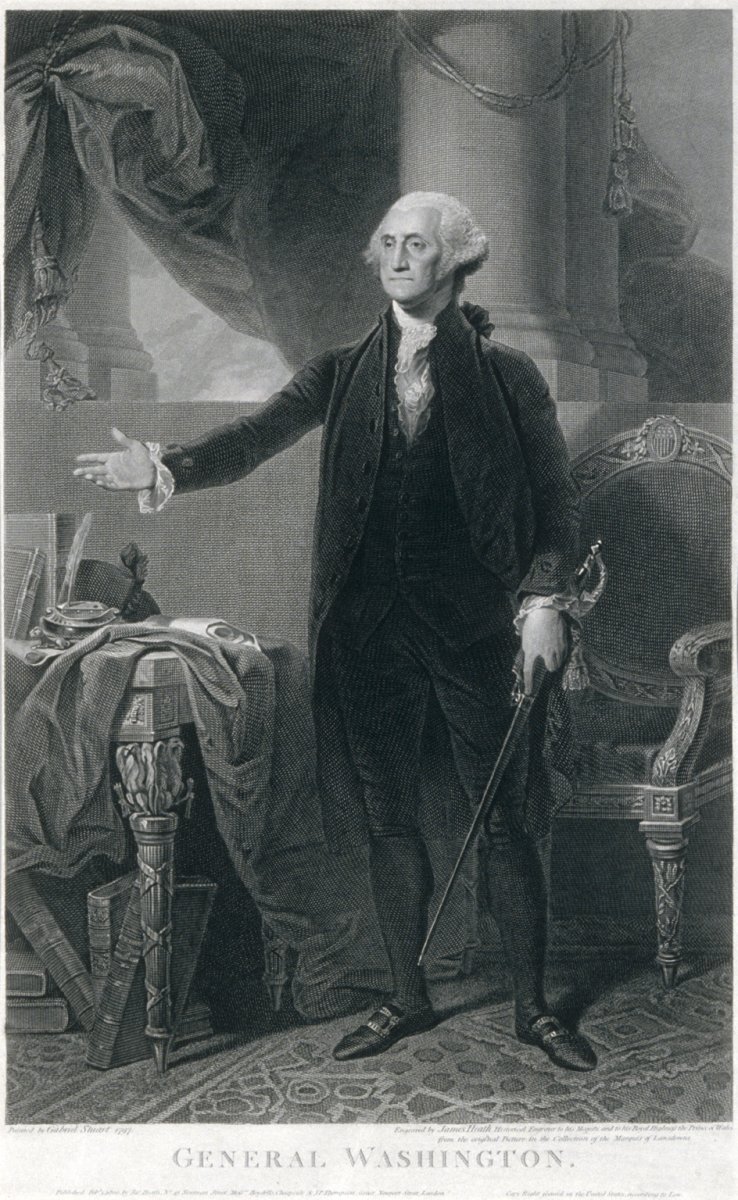George Washington (1732-1799) revolutionary army officer and first President of the United States of America
Gilbert Charles Stuart (1755 - 1828)
James Heath (1757 - 1834)
Engraving
published 1 February 1800
-
About the work
- Location
-
Country: USA
City: Washington DC
Place: British Embassy
This engraving after a portrait of George Washington by artist Gilbert Stuart shows the former American President standing in his office, wearing civilian clothes. Washington holds the Sword of State in his left hand, while his right arm is outstretched in the pose of a Roman Republican senator. The outstretched arm reaches over a table, upon which are books including the ‘Federalist’ and the ‘Journals of Congress’.
Engraved by James Heath, this work was made after the second of three portraits Stuart painted of Washington. The first, known as the Vaughan portrait because it is thought to have been commissioned by trader Samuel Vaughan, was painted in the autumn of 1795. The second is the original work from which this print was engraved; referred to as the Lansdowne portrait because it may have been painted for William Petty, first Marquess of Lansdowne after sittings in April 1796. The original is now in the National Portrait Gallery, Washington DC. Stuart’s third portrait of Washington, known as the Athenaeum portrait, was commissioned by the sitter’s wife. It was painted in 1796 and was later sold to the Boston Athenaeum library. It is now in the collection of the Museum of Fine Arts, Boston.
-
About the artist
Gilbert Charles Stuart was born near Saunderstown, Rhode Island; the son of an inventor and snuff-mill operator. At 14 he became an assistant to Scottish painter C. Alexander. He sailed to Scotland with Alexander in c.1772 but returned by 1774. He relocated to London in 1775 and worked in the studio of B. West. In London J. Boydell commissioned 15 portraits and Lord Percy at least three. Stuart married Charlotte Coates and had twelve children. He moved to Dublin in 1787 and was imprisoned for debt several times before leaving for New York. He worked there until 1795, when he moved to Philadelphia. Here, he met G. Washington, whom he painted three times. He moved to the District of Columbia in 1803 and to Boston in 1805, where he died at 72.
James Heath was born in London; the son of a bookbinder. In 1771 he was apprenticed to engraver J. Collyer the younger. He became a leading engraver in line, stipple and etching. He produced 100 prints after designs by T. Stothard for ‘Novelist’s Magazine’ and numerous works after contemporary artists, including R. Westall and R. Smirke. He also engraved plates for J. Boyell’s Shakespeare Gallery and for his own volumes of Shakespeare’s work. His son George became a serjeant-at-law, while Charles was also an engraver. In 1791 Heath became an associate of the Royal Academy. He was appointed Historical Engraver to George III in 1794 and served as such under successive monarchs. He amassed a considerable fortune before dying in London aged 77.
-
Explore
- Places
- Subjects
- Materials & Techniques
-
Details
- Title
- George Washington (1732-1799) revolutionary army officer and first President of the United States of America
- Date
- published 1 February 1800
- Medium
- Engraving
- Acquisition
- Purchased from Colnaghi, July 1952
- GAC number
- 11941